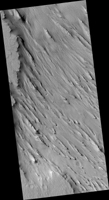
Map Projected Browse Image
Click on the image for larger versionThe purpose of this observation is to determine how these formations, called "yardangs" are forming within a layer of bedrock.
Yardangs are streamlined hills that are carved by wind erosion from bedrock. The rock must be sufficiently erodible for wind to either deflate (pick up) poorly-consolidated pieces or scrape the surface by blowing sand. HiRISE resolution allows us to view yardangs and the component layers more closely, and to get a better understanding of the material.
"Yardang" is a word of Turkish origin, meaning "steep bank." When viewed from above, yardangs can look like the hull of a boat.
HiRISE is one of six instruments on NASA's Mars Reconnaissance Orbiter. The University of Arizona, Tucson, operates the orbiter's HiRISE camera, which was built by Ball Aerospace & Technologies Corp., Boulder, Colo. NASA's Jet Propulsion Laboratory, a division of the California Institute of Technology in Pasadena, manages the Mars Reconnaissance Orbiter Project for the NASA Science Mission Directorate, Washington.

